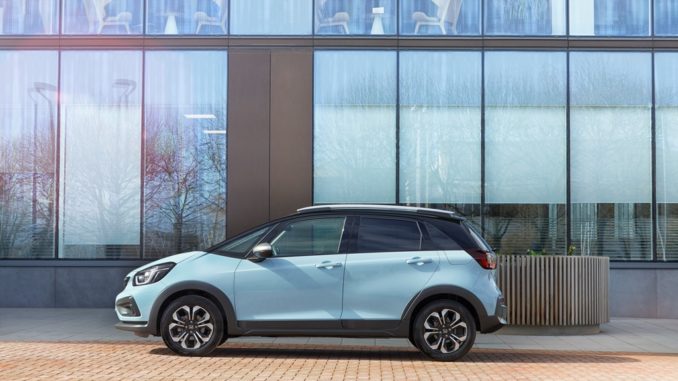
The new Honda Jazz e:HEV put driver and occupant comfort at the heart, thanks the design and ergonomics body stabilising seat frame with supportive mat structure.
By considering all elements of the car as one development team, decisions impacting structure, design and ergonomics were made simultaneously, resulting in class-leading levels of comfort and spaciousness and a significant step forward from its predecessor.
The new front seat mat structure is placed at both the bottom and back of the seat and replaces the S-spring design of previous models. The introduction of a wider seat bottom has allowed the seat pad depth to be increased by 30mm with the additional softness immediately noticeable when seated. This new structure combined with the increased padding allows the cushion to flex moderately but, crucially, to not bottom out.
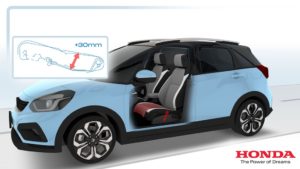 The enhanced structure in the back of the seat increases lumbar and pelvic support to create a body stabilising effect. This helps to prevent fatigue, particularly in the hip and waist area of occupants on longer journeys. Additionally, the new structure makes it easier to maintain a comfortable and stable driving posture, even when cornering and on uneven road surfaces.
The enhanced structure in the back of the seat increases lumbar and pelvic support to create a body stabilising effect. This helps to prevent fatigue, particularly in the hip and waist area of occupants on longer journeys. Additionally, the new structure makes it easier to maintain a comfortable and stable driving posture, even when cornering and on uneven road surfaces.
The newly designed seats are tapered towards the top of the seatback to provide the cushion volume needed to fully support and envelop occupants’ backs. This tapering design also provides a wider space between the front seats making it easier for front and rear occupants to communicate. The lowest point of the seat height is 14mm closer to the ground, which, combined with more rounded front corner cushions, makes it easier to enter and exit the car.
Honda is dedicated to providing comfortable spaces and ultimate driving enjoyment for its customers – said Takeki Tanaka, Large Project Leader for Honda. “While we considered every element of the new Jazz, from seat materials and positioning, to the structure of the car, we also studied people and their bodies to ensure that we provide outstanding levels of comfort. As a result, the latest Jazz retains its reputation for spaciousness and practicality, now with an enhanced sense of refinement in every-day use.
Honda’s engineers and designers also worked together to enhance passenger comfort in the rear of the car. By moving the seat hinges outside of the rear seat back frame, the development team were able to address the comfort of the seat pad. The seat frame pipes have been repositioned allowing engineers to increase the padding thickness by 24mm.
Ergonomic enhancements increase interior comfort
 Honda’s collaborative approach when designing the all-new Jazz allows the car’s structure, seating and controls to work in harmony to optimise driver comfort. A series of subtle adjustments have been made that all contribute to greatly reducing the physical stress of driving.
Honda’s collaborative approach when designing the all-new Jazz allows the car’s structure, seating and controls to work in harmony to optimise driver comfort. A series of subtle adjustments have been made that all contribute to greatly reducing the physical stress of driving.
Ergonomic enhancements include positioning the brake pedal deeper inside the footwell, reducing the need for the seat position to be adjusted for comfortable pedal operation. The angle of the brake pedal has also changed, allowing for an increase in foot angle of five degrees for a more natural pedal action, while the seat has been repositioned accordingly to provide the optimal thigh support.
Setting a comfortable driving position is easier than ever thanks to increased range of steering wheel reach adjustment, bringing the wheel centre up to 14mm closer to the driver. The steering wheel angle is also now two degrees more upright than in the previous model so it’s facing the driver more. As a result of these changes, the amount of arm and shoulder movement required to reach the steering wheel is reduced, improving shoulder-seat separation by 18mm.
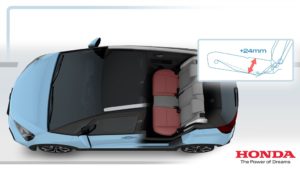 Considerations for rear comfort throughout the structural design process ensure that rear passengers also benefit from best-in-class rear leg room of 989mm, with the front seat guiding rails moved further apart and the width between the rails increased. The fuel tank is packaged in the centre of the chassis beneath the front seats – a unique feature in its class – allowing the new Jazz to retain the versatile rear Magic Seats that offer both ‘fold-flat’ or ‘flip-up’ seat flexibility, depending on cargo space required.
Considerations for rear comfort throughout the structural design process ensure that rear passengers also benefit from best-in-class rear leg room of 989mm, with the front seat guiding rails moved further apart and the width between the rails increased. The fuel tank is packaged in the centre of the chassis beneath the front seats – a unique feature in its class – allowing the new Jazz to retain the versatile rear Magic Seats that offer both ‘fold-flat’ or ‘flip-up’ seat flexibility, depending on cargo space required.
By assessing every conceivable way of improving occupant comfort, ergonomic operation and interior spaciousness, and incorporating them into every part of the design process, Honda has conceived a compelling new proposition in the compact segment. The result is an all-new hybrid city car that combines exceptional efficiency with outstanding everyday usability and comfort, ready to meet the needs of modern consumers.
Source: Honda Europe

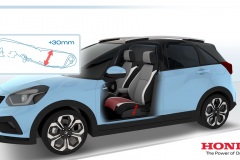
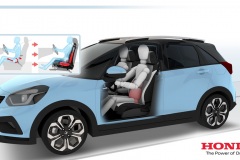

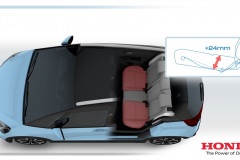

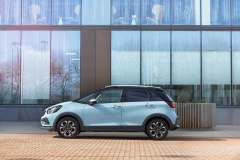
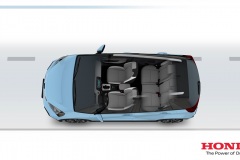
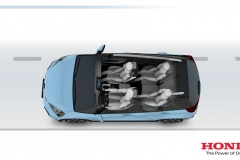
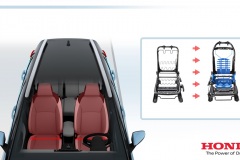
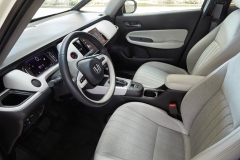
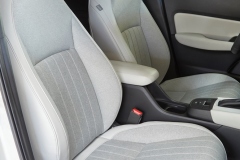




Be the first to comment